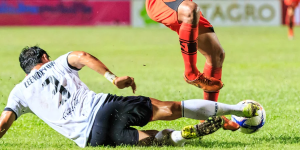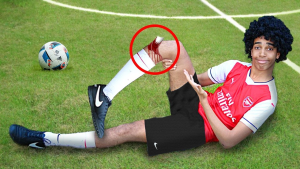
Football is an intense and physical sport, requiring players to perform with speed, strength, and skill. However, this dynamic nature also makes football one of the most injury-prone sports worldwide. Whether on professional pitches or local fields, players of all levels face a range of injury risks. Injury prevention is essential for a long, healthy football career, and proper techniques and strategies can make a difference. Before diving into these strategies, remember that you can keep up with all the live action and insights this season on Xoilac TV for exciting matches and injury-free play.
1. The Most Common Football Injuries
Football injuries can vary widely, from minor bruises to severe ligament tears. Understanding these injuries and their causes is the first step in learning how to prevent them.
- Ankle Sprains: One of the most common injuries in football, ankle sprains happen when the ligaments in the ankle are overstretched or torn. This can occur during sudden changes in direction or from landing awkwardly after a jump.
- Hamstring Strains: The hamstrings are highly susceptible to injury, especially during sprinting. Hamstring strains range from mild overstretching to severe muscle tears, often caused by rapid acceleration or deceleration.
- Knee Injuries (ACL, MCL): The knee, a major weight-bearing joint, is vulnerable to injuries, particularly to the anterior cruciate ligament (ACL) and medial collateral ligament (MCL). Sudden stops, twists, or collisions often lead to these injuries, which can require long recovery times.
- Groin Pulls: The groin muscles, used heavily in lateral movements, can be strained or torn during sudden side-to-side movements, common in football.
- Shin Splints: Pain in the shin area, commonly called shin splints, often results from repetitive stress or overuse, especially on hard playing surfaces.
- Concussions: Although less common than lower-body injuries, concussions are a serious concern in football, especially from head-to-head collisions or heading the ball improperly.
2. Conditioning and Strength Training
One of the most effective ways to prevent injuries is through proper conditioning and strength training. Football requires strength, speed, agility, and endurance. A well-rounded training program can help build the muscles and stability needed to prevent injuries.
- Lower Body Strength: Strong leg muscles, including the quadriceps, hamstrings, calves, and glutes, are essential for supporting movements on the field. Exercises such as squats, lunges, and leg presses can help improve strength in these areas.
- Core Strength: A strong core supports the entire body, enhancing balance and stability. Planks, Russian twists, and other core exercises are beneficial for preventing injuries.
- Agility Drills: Football involves frequent changes in direction. Agility drills, such as ladder drills or cone exercises, improve reaction time and control, helping players avoid awkward movements that lead to sprains or strains.
- Balance Training: Balance exercises, such as single-leg stands or Bosu ball exercises, are effective for strengthening stabilizer muscles around the ankles and knees, reducing the risk of twists and sprains.
3. Warm-Up and Stretching
A proper warm-up is critical for injury prevention. Warming up prepares the muscles for intense activity, increases blood flow, and reduces stiffness, all of which help prevent injuries.
- Dynamic Stretching: Unlike static stretching, dynamic stretching involves moving parts of your body in controlled, repetitive movements that gradually increase reach and speed. Examples include leg swings, arm circles, and lunges with a twist. Dynamic stretching before training or a match helps warm up the muscles and enhances range of motion.
- Joint Mobilization: Exercises that promote flexibility and mobility in the joints are essential, especially for the hips, knees, and ankles. Gentle joint rotations and dynamic exercises like walking lunges can help loosen these areas.
- Activation Exercises: These exercises activate specific muscles, like the glutes and core, before play. Glute bridges, for instance, help engage the gluteal muscles and prepare them for the demands of the game.
4. Proper Technique and Form
Using proper technique is essential to prevent injuries. Incorrect techniques in tackling, sprinting, or even landing can lead to injuries, sometimes severe ones.
- Learning Tackling Technique: Tackling is one of the most common causes of injuries in football, especially in amateur play. Players should be taught the correct tackling form, ensuring they don’t lead with their heads or twist awkwardly.
- Landing Techniques: Many knee and ankle injuries happen when players land improperly after jumping. Learning to land with bent knees and distributing weight evenly can reduce the impact on joints.
- Ball-Handling Technique: Head injuries often occur when players improperly head the ball. Coaches should teach players how to strike the ball with the forehead and maintain proper posture, helping prevent concussions and neck strains.

5. Hydration and Nutrition
Staying hydrated and eating a balanced diet are essential for maintaining peak physical condition. Dehydration and improper nutrition can contribute to muscle cramps, fatigue, and poor performance, all of which increase the risk of injury.
- Hydration: Dehydration affects performance and increases the likelihood of muscle cramps. Players should drink water or electrolyte-rich drinks before, during, and after training or matches, especially in hot weather.
- Balanced Diet: A diet rich in lean proteins, complex carbohydrates, healthy fats, and plenty of fruits and vegetables supports muscle recovery and endurance. Nutrients like calcium and vitamin D are also vital for bone health, reducing the risk of fractures.
6. Footwear and Protective Gear
Choosing the right equipment, especially footwear, can make a significant difference in injury prevention.
- Footwear: Football boots should be selected based on the playing surface. For example, boots with longer studs are suitable for soft, muddy fields, while short studs or turf shoes are better for firmer ground. Proper-fitting shoes provide the support needed to reduce ankle and knee injuries.
- Shin Guards: Shin guards protect the lower legs and reduce the risk of fractures and bruises. It’s essential to choose a pair that fits properly and covers the shin area well.
- Headgear: Although not commonly used, protective headgear can reduce the impact of head collisions and minimize the risk of concussions. Some players, especially younger or more vulnerable ones, may benefit from using headgear in contact-heavy situations.
7. Recovery and Rest
Rest and recovery are crucial parts of any injury prevention program. Intense physical activity creates micro-tears in muscles, and adequate rest allows these to heal and grow stronger. Without proper recovery, players become more prone to overuse injuries and strains.
- Sleep: Quality sleep is essential for muscle repair and overall recovery. Players should aim for 7-9 hours of sleep each night, especially during intense training periods.
- Ice and Compression Therapy: After training or matches, icing and using compression can help reduce inflammation and speed up recovery. This is particularly useful for managing any soreness or minor strains.
- Foam Rolling and Massage: Foam rolling and massage help alleviate muscle tightness and prevent injuries caused by stiff muscles. Regularly using these methods as part of post-training routines can keep muscles loose and responsive.
8. Listening to Your Body
One of the most effective injury prevention strategies is simply listening to your body. Ignoring early signs of discomfort or pain can lead to severe injuries.
- Recognizing Signs of Overuse: Mild soreness is normal after intense play, but persistent or sharp pain often indicates an underlying issue. Rest or consult with a medical professional if you experience unusual discomfort.
- Don’t Rush Back After Injury: After an injury, it’s crucial not to rush back onto the field. Following a full rehabilitation program and gaining medical clearance can help prevent reinjury.

9. Educating Coaches, Players, and Parents
Education plays a key role in preventing injuries in football, especially at the youth and amateur levels. Players, coaches, and even parents should be educated on proper techniques, conditioning practices, and the importance of safety.
- Coach Training: Coaches should be well-versed in injury prevention techniques, first aid, and emergency response. Training courses for coaches on injury prevention can be immensely beneficial.
- Teaching Young Players: Injury prevention habits should be introduced early. By teaching young players the fundamentals of warming up, cooling down, and playing safely, we can reduce the likelihood of injuries throughout their careers.
- Encouraging a Safe Environment: An environment where players feel safe reporting injuries or discomfort without judgment is essential. It’s vital for players to prioritize their health and understand that taking time to recover is a sign of strength, not weakness.
Football Safety for All
Injury prevention in football is more than just a set of rules; it’s a commitment to player health and well-being. These strategies, from conditioning to proper technique and recovery, are essential to keeping players safe on the field. With education, discipline, and attention to safety, football can remain a thrilling and rewarding experience for everyone involved.
To see players in action while remaining injury-free, tune in to Xoilac tv truc tiep bong da and follow all the live football excitement this season. Watching your favorite players excel safely on the field adds another layer of enjoyment to the game, underscoring the importance of injury prevention at every level.